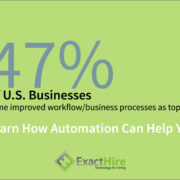What Is Your Onboarding Data Telling You?
An effective onboarding process can have a positive impact on nearly every aspect of your business, from improving retention and engagement to strengthening your company’s culture and employer brand. But to create a stellar onboarding process, you need to understand where you’re currently falling short. That’s where your onboarding data comes in.
Data and KPIs will help you identify ways you can improve your onboarding process. Over time, you can see how your onboarding improvements contribute to your company’s success. In this article, we’ll show you why onboarding data is important, the most important onboarding data you need to track, and ways you can improve your onboarding process.
New Hire Onboarding Statistics
Half of new hires leave in the first 18 months of employment, according to onboarding statistics by SHRM. And that turnover is expensive. SHRM onboarding statistics in 2022 also say filling that empty chair costs up to nine months of that position’s salary. Yet many new hires leave before the company ever sees a return on their recruiting investment.
According to statistics, the importance of onboarding is the key to guiding new hires through those potentially sticky first months of employment, when they must merge their enthusiasm for their new role with its realities. Onboarding is also the company’s opportunity to deliver on the employee value proposition (EVP) they promoted during the recruitment process.
In fact, not delivering on promises is the fastest growing cause of voluntary turnover. According to The Work Institute’s 2020 Retention Report, the percentage of those who cited disappointment with a job’s characteristics as a reason for leaving more than doubled since 2013.
Good onboarding can prevent all of the preventable reasons for turnover cited in the Retention Report. Yet most companies do a bad job of onboarding according to statistics. According to onboarding statistics by Gallup, only 12% of employees think their company hits onboarding out of the park. That means 88% of companies need to improve their onboarding process.
Important Employee Onboarding Data
Your company can improve its onboarding process by collecting and analyzing onboarding data. But which data, exactly, can help you improve your onboarding process?
How to Measure Employee Turnover
Turnover measures how many people leave your company over a given period, usually annually. Measure turnover by dividing the number of employees leaving by the number of employees at the start of the given time period. Compare your results with the national average for your industry or region using the annual total separations compiled by the Bureau of Labor Statistics.
You can also break down your turnover measurements further by separating voluntary from involuntary turnover or by focusing on new hire turnover.
How to Measure Employee Engagement
Employee engagement is one of the most important predictors of company growth and can be improved significantly with an effective onboarding process. You can measure employee engagement by conducting a company-wide survey based on Gallup’s Employee Engagement Survey.
You can use the results of your employee engagement survey to make focused improvements to your onboarding process. Then, by conducting the survey periodically, you’ll know if your onboarding process is improving employee engagement.
How to Measure Time to Productivity
Time to productivity is more difficult to measure but essential to improving your onboarding process.
First, develop measurable, time-bound KPIs for the new position. These KPIs are tasks which you expect the new hire to accomplish independently within a predetermined time.
Then, divide the number of days it should take the new hire to accomplish the tasks independently by the number of days it actually takes the new hire to achieve the KPI.
For example, perhaps you expect Susan to operate the telephone switchboard independently after 5 days of training. If Susan masters the switchboard within 3 days, then her rating for time to productivity is 1.66, or 166% of the goal KPI.
Employee Onboarding Experience
You can use your onboarding data to know the effectiveness of your onboarding process and to identify areas of improvement. But what makes a great onboarding process?
A great onboarding process emphasizes the employee, rather than paperwork and processes. It’s an onboarding concept in HR by which you focus on providing the new hire with the 4 Cs.
- Compliance: These are the basics and include paperwork, policies, and rules. While your safety and harassment policies are crucial, it’s the other four Cs that will help you improve employee retention.
- Clarification: A great onboarding process provides the new hire with clarity regarding her role and responsibilities.
- Culture: Forbes says, “a strong company culture is the best retention strategy.” Your company’s culture reflects the values from which decisions are made. Including culture in your onboarding process ensures new hires align themselves with the company’s values.
- Connection: To understand how important connection at work is, you only need to take a look at Maslow’s hierarchy of needs. After our physical needs are met, a “feeling of belonging” becomes the most important ingredient to happiness. The best onboarding processes recognize the new hire’s need for belonging and use creative solutions to foster connectedness.
Best Onboarding Practices
Your onboarding data may have revealed shortcomings in one or more of the 4 Cs of onboarding. The following best onboarding practices for new employees will help you improve every aspect of your onboarding process.
Improve Compliance
- Use an applicant tracking system and onboarding software to digitize your data and forms. Companies with the best onboarding practices in 2021 take full advantage of technology. When applicants and new employees fill out their information with the software, the data can be automatically transferred to a variety of HR forms and files.
- Create online training modules and assessments to ensure new hires understand important policies and rules in the employee handbook.
Improve Clarification
- Document every position’s duties and responsibilities.
- Using this document, create a comprehensive training timeline.
- Assign a stakeholder who will be responsible for each item in the training timeline.
- Provide opportunities for new hires to ask questions.
- Schedule periodic check-ins to ensure the new hire stays on track.
Improve Culture
- Create a training that introduces your new hire to the company’s history, values and mission.
- Connect your new hire’s role to the company’s larger purpose.
- Recognize your new hire’s accomplishments.
- Communicate frequently with your new hire and provide frequent feedback.
Improve Connection
- Assign a long-term employee to act as a buddy to your new hire. The buddy should help the new hire learn the unspoken rules of the company and be available for questions.
- Introduce your new hire throughout the company. Introductions within the team should be more personable. Introductions to the larger company can be made via a posting on the company’s intranet or other common area.
- Send your new hire to work a day in different departments. Doing so will enhance relationships as well as dismantle silos.
Employee Onboarding Checklist
An employee onboarding checklist is a great way to make sure you don’t forget anything when onboarding new hires. The checklist can include everything in the onboarding process throughout the first year.
You can use employee onboarding data and software to create custom checklists for each position. Stakeholders can update the checklist within the software as the new hire completes the onboarding process.
You can also download ExactHire’s “The Essential Onboarding Checklist.” We’ve created a comprehensive new employee onboarding guide pdf to get new hires up and running. Our checklist is an onboarding strategy divided by time frame and category and breaks down everything you need to do within the new hire’s first year.
Sample Onboarding Plan
A sample onboarding plan for new employees can solve a host of business problems. Everything from high turnover to low engagement and poor productivity can be turned around by a great onboarding plan. But to craft that plan, you need to measure key onboarding data. When you measure the most important KPIs of onboarding, including onboarding experience surveys, you can begin to create a plan that will ultimately improve business outcomes.
The improvements you make should address the 4 Cs of onboarding: compliance, clarification, culture and connection. The onboarding tips for new employees we’ve listed are a great start to revamping your onboarding process. You can further improve your onboarding for new employees for maximizing success when you download our checklist.
Using onboarding software can automate many of your onboarding action items. By having a centralized place that tracks onboarding efforts, stakeholders will always know the next steps and you’ll always know the status of a new hire’s onboarding process.
If you’re ready to learn more about how onboarding software can improve your business, contact ExactHire today.
Photo by Tim Mossholder on Unsplash









